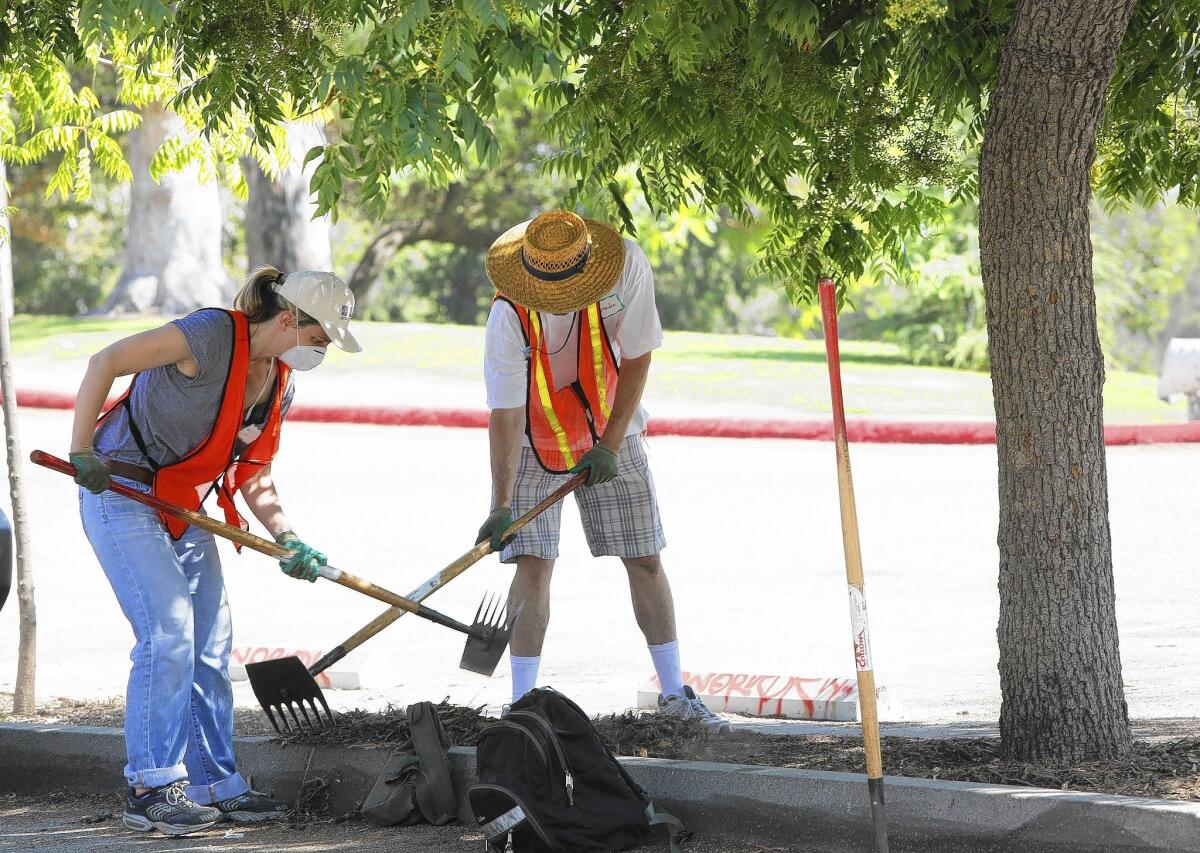Improvised devices help water drought-stricken L.A. trees

Los Angeles officials and environmentalists have begun deploying emergency low-tech watering devices to try to save trees in desperate need of water during the drought.
The improvised contraptions, called drought response irrigation pods or “irricades,” are made with hollow, plastic traffic barriers and filled with recycled water that slowly trickles into the soil through attached soaker hoses.
Volunteers with the environmental group TreePeople joined Los Angeles Department of Recreation and Parks staff on a recent morning to install the devices for the first time among rows of Chinese pistache in a parking lot in Griffith Park. The shade trees have lost leaves, had chunks of bark chewed off by squirrels and shown other signs of distress.
“The trees are extremely thirsty and stressed, so we need to provide them any water we can to sustain them through these hot summer months,” said Laura Bauernfeind, principal forester for the city parks department, which manages more than 16,000 acres of parkland with more than 400 species of trees, many without any source of irrigation.
The lack of root-soaking rainfall during one of California’s worst droughts in decades has strained trees throughout Los Angeles, making them more vulnerable to insect infestation, disease and other problems that can ultimately kill them, Bauernfeind said.
Even native California trees that are adapted to the region’s Mediterranean climate of dry summers are showing signs of drought stress, she said. Species accustomed to more steady infusions of water, such as sycamores and alders, are having a particularly hard time.
Andy Lipkis, president of TreePeople, said trees at the group’s headquarters in Coldwater Canyon Park near Beverly Hills started dying off during the winter and spring. Among the agents of destruction were squirrels and other rodents gnawing at oaks in search of moisture in their roots.
“It was like we had beavers,” Lipkis said. “We’ve never seen that before.”
When the group contacted city parks staff, they confirmed they were experiencing some of the same problems, Lipkis said. “We knew that we needed to do something.”
The solution was inspired by Australia’s use of similar roadside barriers to water trees during its decadelong “millennium drought,” which ended in 2009.
After studying the technique on several recent trips to the country, Lipkis and his staff developed and tested their own prototypes before convincing the city to try them in Griffith Park.
Giving urban trees help to survive the drought is crucial, Lipkis said, because they do so much for city residents, including providing an important buffer against rising temperatures from climate change.
The 160-gallon traffic barriers are being filled with reclaimed water from sewage treatment plants, a source already used to irrigate major portions of 4,200-acre Griffith Park.
The city parks department, which is paying for the water and the materials, has committed to using the devices only on a trial basis through the summer. But if the drought persists, the makeshift systems could be installed elsewhere. They are simple, inexpensive and portable enough that park managers can set up them almost anyplace to help trees not served by traditional irrigation lines.
City officials had been looking hopefully at long-term forecasts earlier this year that indicated a powerful El Niño had a good chance of developing in the Pacific Ocean this year and bringing a boost in much-needed rainfall to Southern California.
But as the predictions of a strong El Niño have fizzled, park managers have begun planning for the possibility of another dry winter. Even if El Niño does occur, history shows it offers no guarantee of a wetter winter.
Prolonged drought could do some good by inspiring new measures like the irricades and by forcing Los Angeles to get creative about dealing with unpredictable precipitation patterns, organizers of the tree-watering initiative said.
Leon Boroditsky, a tree surgeon with the city parks department, said the watering devices will probably keep trees alive if the water saturates roots 3 feet underground.
“The real question is: When do we get rain again?” Boroditsky said.
Twitter: @tonybarboza
More to Read
Sign up for Essential California
The most important California stories and recommendations in your inbox every morning.
You may occasionally receive promotional content from the Los Angeles Times.











